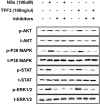Nucleotide-mediated SPDEF modulates TFF3-mediated wound healing and intestinal barrier function during the weaning process
- PMID: 29555969
- PMCID: PMC5859294
- DOI: 10.1038/s41598-018-23218-4
Nucleotide-mediated SPDEF modulates TFF3-mediated wound healing and intestinal barrier function during the weaning process
Abstract
Most alterations during weaning involve physiological changes in intestinal structure and function. Here, we evaluated the molecular mechanisms regulating the effects of nucleotides on weaning. Nucleotide treatment induced Trefoil factor 3 (TFF3) expression and IPEC-J2 cell growth and reduced wound width. Treatment with nucleosides and TFF3 in lipopolysaccharide-challenged IPEC-J2 cells increased intestinal transepithelial electrical resistance and decreased intestinal permeability. Additionally, nucleosides improved intestinal barrier function through induction of TFF3-mediated phosphatidylinositol 3-kinase/Akt, extracellular signal-regulated kinase 1/2, p38, and Janus kinase/signal transducer and activator of transcription signaling pathways. Among selected differentially expressed genes, SAM pointed domain containing ETS transcription factor (SPDEF) expression was elevated by nucleotides in a concentration-dependent manner. Moreover, SPDEF directly regulated TFF3 expression via binding to the promoter. In vivo, nucleotide supplementation improved growth performance, serum stress levels, and intestinal morphology. Our findings provide insights into the molecular mechanisms of intestinal development during weaning in pigs.
Conflict of interest statement
The authors declare no competing interests.
Figures









Similar articles
-
Proteomic analysis reveals the molecular mechanism of Hippophae rhamnoides polysaccharide intervention in LPS-induced inflammation of IPEC-J2 cells in piglets.Int J Biol Macromol. 2020 Dec 1;164:3294-3304. doi: 10.1016/j.ijbiomac.2020.08.235. Epub 2020 Sep 1. Int J Biol Macromol. 2020. PMID: 32888998
-
Signal transduction and gene transcription induced by TFF3 in oral keratinocytes.Eur J Oral Sci. 2009 Oct;117(5):511-7. doi: 10.1111/j.1600-0722.2009.00652.x. Eur J Oral Sci. 2009. PMID: 19758246
-
MicroRNA-7-5p regulates the proliferation and migration of intestinal epithelial cells by targeting trefoil factor 3 via inhibiting the phosphoinositide 3-kinase/Akt signalling pathway.Int J Mol Med. 2017 Nov;40(5):1435-1443. doi: 10.3892/ijmm.2017.3120. Epub 2017 Sep 6. Int J Mol Med. 2017. PMID: 28901375 Free PMC article.
-
Ets transcription factors in intestinal morphogenesis, homeostasis and disease.Histol Histopathol. 2008 Nov;23(11):1417-24. doi: 10.14670/HH-23.1417. Histol Histopathol. 2008. PMID: 18785124 Free PMC article. Review.
-
The role of SPDEF in cancer: promoter or suppressor.Neoplasma. 2022 Dec;69(6):1270-1276. doi: 10.4149/neo_2022_220529N571. Epub 2022 Aug 11. Neoplasma. 2022. PMID: 35951453 Review.
Cited by
-
Spirobenzofuran Mitigates Ochratoxin A-Mediated Intestinal Adverse Effects in Pigs through Regulation of Beta Defensin 1.Toxics. 2024 Jul 3;12(7):487. doi: 10.3390/toxics12070487. Toxics. 2024. PMID: 39058139 Free PMC article.
-
The Impact of Weaning Stress on Gut Health and the Mechanistic Aspects of Several Feed Additives Contributing to Improved Gut Health Function in Weanling Piglets-A Review.Animals (Basel). 2021 Aug 17;11(8):2418. doi: 10.3390/ani11082418. Animals (Basel). 2021. PMID: 34438875 Free PMC article. Review.
-
Establishment of a chicken intestinal organoid culture system to assess deoxynivalenol-induced damage of the intestinal barrier function.J Anim Sci Biotechnol. 2024 Feb 18;15(1):30. doi: 10.1186/s40104-023-00976-4. J Anim Sci Biotechnol. 2024. PMID: 38369477 Free PMC article.
-
Eckol Alleviates Intestinal Dysfunction during Suckling-to-Weaning Transition via Modulation of PDX1 and HBEGF.Int J Mol Sci. 2020 Jul 3;21(13):4755. doi: 10.3390/ijms21134755. Int J Mol Sci. 2020. PMID: 32635412 Free PMC article.
-
Role of trefoil factors in maintaining gut health in food animals.Front Vet Sci. 2024 Nov 19;11:1434509. doi: 10.3389/fvets.2024.1434509. eCollection 2024. Front Vet Sci. 2024. PMID: 39628866 Free PMC article. Review.
References
Publication types
MeSH terms
Substances
LinkOut - more resources
Full Text Sources
Other Literature Sources

